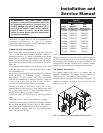
Hydronic Heating Boilers and
Domestic Water Heaters
28
INSTALLATION
Continued
CONNECTING TO GAS SUPPLY
Only supply gas type specified on the unit’s rating plate. This
unit is orificed for operation up to 2000 feet altitude. If
installing above 2000 feet elevation, consult the appliance
manufacturer.
INLET PRESSURE: Measure inlet pressure at the inlet
pressure tap located upstream of the combination gas valve(s).
See TABLE–I for maximum and minimum inlet pressures. Do
not exceed the maximum. Minimum inlet pressure is for the
purpose of input adjustment.
TABLE–H
Inlet P
MANIFOLD PRESSURE: Measure manifold pressure at the
pressure tap on the downstream side of the combination gas
valves. The gas regulator on the unit’s combination gas valve is
adjustable to supply proper manifold pressure for normal
operation. See TABLE–M, page 32 for net manifold pressure
settings.
If you must adjust regulator pressure, follow the instructions
under Gas Manifold Pressure Adjustment, page 31. Do not
increase regulator pressure beyond specified pressure setting.
Gas Pressure Test
1. Disconnect unit from the gas supply piping system during
any piping system pressure testing greater than 1/2 PSIG
(3.5kPa).
2. Isolate the unit from the gas supply piping system by
closing a manual shutoff valve during any piping system
pressure testing that is equal to or less than 1/2 PSIG
(3.5kPa).
3. Test all gas connections for gas leaks before placing unit in
operation.
Gas Piping
To safely operate this unit, you must properly size the gas
supply piping. See TABLES-J, K, & L for piping and fitting
requirements. Gas pipe size may be larger than heater
connection.
For ease of service, install a union.
Install a manual main gas shutoff valve, outside of the unit gas
connection within six feet of the unit in accordance with the
requirements of the National Fuel Gas Code, ANSI Z223.1.
You must provide a sediment trap (drip leg) in the inlet of the
gas connection to the unit.
The combination gas valves have an integral vent limiting
device and do not require venting to atmosphere, outside the
building. The unit will not operate properly if the reference
hose is removed or a vent to atmosphere is installed.
Optional gas controls may require routing of bleeds and vents
to the atmosphere, outside the building when required by local
codes.
Connecting Gas Piping to Unit
All gas connections must be made with pipe joint compound
resistant to the action of liquefied petroleum (L.P.) and natural
gases. All piping must comply with local codes and ordinances.
Piping installations must comply with approved standards and
practices.
1. Make sure gas line is a separate line direct from the meter
unless the existing gas line is of sufficient capacity. Verify
pipe size with your gas supplier.
Max. Min.
Nat. Gas 10.5" w.c. 4.5" w.c.
LP Gas 13" w.c. 8" w.c.
TABLE-I
Inlet Pressure
NOTE: It is the installer’s responsibility to supply
the sediment trap (drip leg).
IMPORTANT: Do not block access to the electrical
cover plate when installing the sediment trap. The
sediment trap must be a minimum of 12 inches
from the appliance.


















